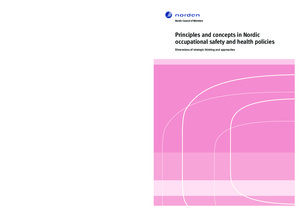Principles and concepts in Nordic occupational safety and health policies : dimensions of strategic thinking and approaches
"The objective of the study is to compare Nordic programs on the working environment and safety and health at work as well as their strategic approaches. Another aim is to interpret the differences, similarities, and semantic relations between national (Nordic) working environment programs and...
| Main Authors: | , |
|---|---|
| Institution: | ETUI-European Trade Union Institute |
| Format: | TEXT |
| Language: | English |
| Published: |
Copenhagen
2008
Nordic Council of Ministers |
| Subjects: | |
| Online Access: | https://www.labourline.org/KENTIKA-19187710124919059929-Principles-and-concepts-in-Nor.htm |
| Summary: | "The objective of the study is to compare Nordic programs on the working
environment and safety and health at work as well as their strategic approaches. Another aim is to interpret the differences, similarities, and semantic relations between national (Nordic) working environment programs and the European Union’s corresponding ones. This is done with regard
to the strategic lines of the programs and the contents of the procedural programs. The objective of the study is to further the discussion among the Nordic countries on the situation of their country-specific strategies/programs.
The Nordic policies on health and safety at work are examined in light of the country-specific strategies/programs on health and safety at work. The background programs and comparison criteria encompass the European Union’s strategies on health and safety at work for the years 2002–2006
and 2007–2012 and the Programme for the Nordic Council of Ministers’ co-operation in the labour market and working environment sectors 2005–2008.
The research is conducted through a qualitative content analysis. In the rst phase of the analysis, the material was studied iteratively to find the common, reduced themes of all the programs/strategies: the objectives, means, action level, actor level, and authority activity. In the next phase, the themes were examined by looking for differences and similarities of expression between the programs/strategies, whereupon different contentrelated strategy dimensions were derived. The analysis continued by examining each background and country-speci c program from the viewpoint of these strategy dimensions.
Based on the above analysis, one may conclude that the European Union’s programs and the Nordic program emphasize quite different viewpoints. The state has a different role in these programs, which results in different cultures regarding the OSH (Occupational Safety and Health) policy practices and their amendment. The EU strategy has a distinctly reformative role; it is aimed at leading the member states toward a new way of thinking. The Nordic strategy is a mere account of the prevailing thinking in the Nordic countries, and therefore it emphasizes state-centred, traditional features in comparison to the programs of the European Union.
Especially the objectives and means of the Nordic country-specific programs deviate from their background programs. Except for Denmark, the Nordic countries have relatively general and principled objectives concerning their ideologies on health and safety at work. The actor practices of the Finnish program are the closest match to the EU programs. When comparing the country-specific programs/strategies, the consulta12Nordic OSH Policies tive nature of authority action stands out as a distinct feature of the Finnish strategy. The Swedish program is characterized by the prioritization of
objectives from the starting point of certain lines of business. The special feature of the Norwegian strategy is its authority-oriented actor level. The Danish program is marked by rewarding, punitive, and controlling authority action, and the Icelandic by the concrete means through which its objectives are pursued. To sum it up, the Nordic countries appear dissimilar – even divergent – in regard to the salient content dimensions of their strategies on safety and health at work." |
|---|---|
| Physical Description: | 120 p. Paper Digital |

